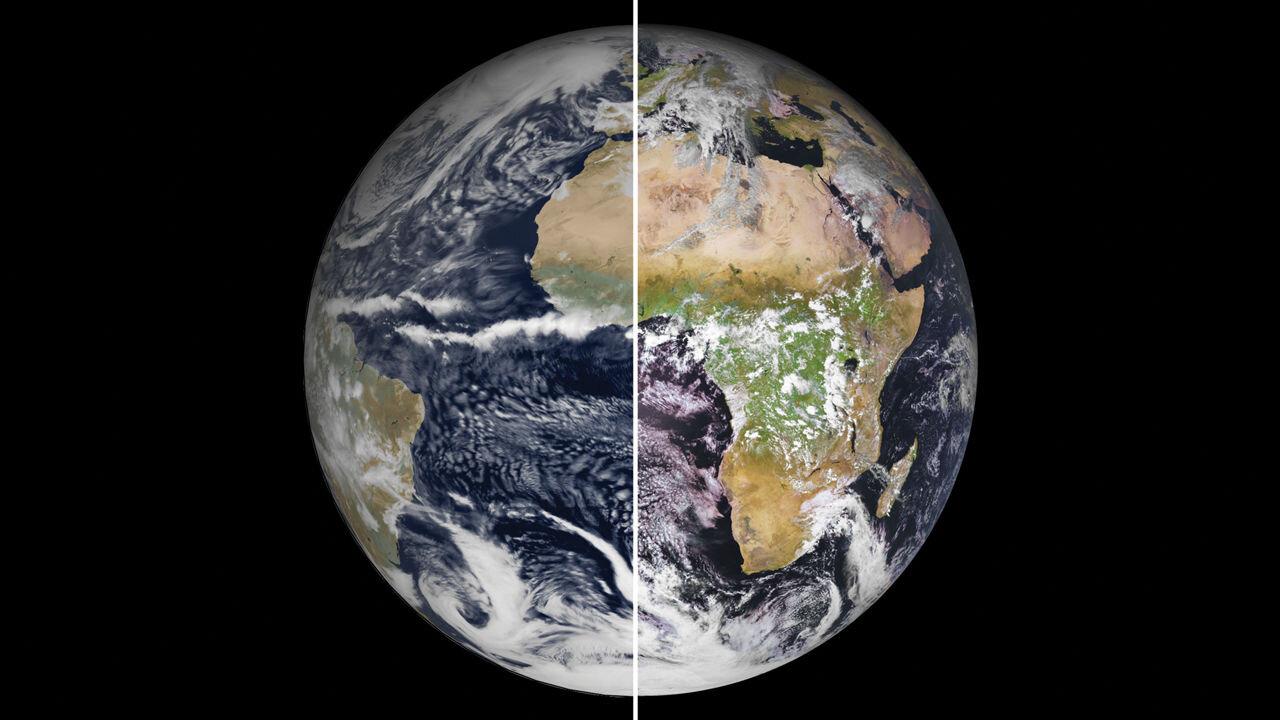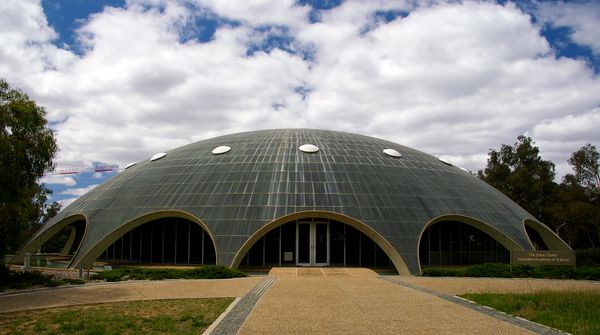Building Australia's Downward Looking Telescope
AuScope’s Downward Looking Telescope (DLT) is the Australian geoscience research community’s vision for a futureproof research infrastructure system to support Australia’s sustainable future. Image: AuScope
This article was originally published by AuScope, Australia’s provider of research infrastructure to the Earth and Geospatial Science community. AuScope is an Australian Government (NCRIS) organisation that has enabled the research, or research infrastructure, described here. Author: Philomena Manifold. Contact AuScope's CEO, Dr Tim Rawling for more information.
Science evolves from the capacity to see and think differently. AuScope’s DLT is our vision for a futureproof research infrastructure system that will allow researchers to ‘see’ into Earth and capture, focus and analyse data to help us think deeply about Australia’s future. Here we explain each DLT Components and what they mean for Australia’s research community.
Overview
The DLT comprises an integrated system of Earth and geospatial instruments, services data and analytics that was envisioned by the Australian geoscience community between 2018 – 2020, and documented in AuScope’s Strategy 2020 – 2030 and 5-Year Investment Plan. It will enable researchers to ‘see’ into the Earth, and make inspiring and powerful new observations for Australia’s sustainable future.
“The reward of the young scientist is the emotional thrill of being the first person in the history of the world to see something or to understand something. Nothing can compare with that experience.”
— Astronomer and astrophysicist, Cecilia Payne-Gaposchkin
The DLT comprises five Components: the Temporal Lens, the Observational Lens, the Characterisation Lens, the Data Framework and the Analytical Framework. Each includes a number of existing and future AuScope Programs. Please read on to learn more about the DLT, and our steps to bring it to life.

Temporal Lens
Allowing researchers to analyse the Earth’s evolution through time
The DLT’s Temporal Lens will comprise a suite of geochemistry and geochronology analytical services, data and analytics that will enable researchers to investigate the evolution of Earth, and other celestial bodies, through deep time with unprecedented accuracy. Importantly, it will enable researchers to help locate new critical mineral resources that will underpin sustainable infrastructure and innovation, provide new export opportunities, and support better climate forecasting models by providing high resolution records of the past.
Our challenge: Australia has many world-class geochemistry and geochronology laboratories, though the community recognise some technology gaps and unstandardised data delivery workflows across them. As such, users of data produced in these laboratories find it challenging to make useful data products such as national maps. Additionally, as some instruments approach end-of-life, the risk of ensuing critical data gaps increases.
The Temporal Lens will help to overcome these challenges through nine Programs. Please visit AuScope’s 5-Year Investment Plan for details on all Programs in this DLT Component.

Discover current (coloured circles) and future (white circles) Programs in each DLT component in AuScope’s 5-Year Investment Plan (in detail) or Strategy 2020 – 2030 (high level). Image: AuScope

Observational Lens
Allowing researchers to observe changes in the structure of the Earth
The DLT’s Observational Lens will include a distributed array of geophysical sensors across the Australian continent that will monitor the physical properties of the Earth, and changes occurring over the decades ahead. This will enable researchers to better understand and even predict important natural and human-induced environmental changes and geohazards over time.
Our challenge: Australia is a vast continent and whilst between AuScope, Geoscience Australia, CSIRO and various universities there are significant observational infrastructure systems in place, the coverage remains sparse and the rate of observation prohibitively slow. In order to provide the data density and richness required to allow predictive, near real-time approaches for resource discovery, hazard management and continental-scale tectonic analysis, investment in the DLT is essential.
This Observational Lens will help to overcome this challenge through eight Programs. Please visit AuScope’s 5-Year Investment Plan for details on all Programs in this DLT Component.

Discover current (coloured circles) and future (white circles) Programs in each DLT component in AuScope’s 5-Year Investment Plan (in detail) or Strategy 2020 – 2030 (high level). Image: AuScope

Characterisation Lens
Allowing researchers to classify rocks based on their properties
The DLT’s Characterisation Lens will provide researchers with the essential petrophysical properties necessary to accurately infer subsurface architecture and gain mechanistic insights into Earth processes.
Our challenge: to characterise the shallow or accessible portion of Earth’s crust across the Australian continent, which is currently largely limited to the domain of mineral and energy exploration companies. Typically, their approach to data acquisition is highly dependent on the commodity of interest, however, much potentially valuable data is either never collected or discarded, precluding use by others across research and industry. Providing support to geological surveys and academic geoscientists through borehole access, instrumentation and development of new characterisation technologies will revolutionise the quality and resolution of the data available from the shallow crust and the geological services it provides.
The Characterisation Program will help to overcome this challenge through seven integrated Programs. Please visit AuScope’s 5-Year Investment Plan for details on all Programs in this DLT Component.

Discover current (coloured circles) and future (white circles) Programs in each DLT component in AuScope’s 5-Year Investment Plan (in detail) or Strategy 2020 – 2030 (high level). Image: AuScope

Data Framework
Allowing researchers to access and use diverse standardised data
The DLT’s Data Framework lens will capture and create Findable, Accessible, Interoperable and Reusable (FAIR) data from the three DLT Lenses, in preparation for researchers to make sense of it in the Analytical Framework.
Our Challenge: The Australian geoscience community recognises the importance of research data management, instrumentation data pipelines and data access portals for future research. As such, the DLT’s Data Framework, AuScope will i) capture data automatically at the point of creation, ii) hold data to FAIR data standards, iii) open data to community data repositories; and iv) deliver data as high-performance datasets for data-intensive research. AuScope also recognises the importance of data stewardship over community created, used and managed data. As such, we will build capacity within our geoscience community to safeguard geoscience data, develop a community of practice around that data, and support researchers in data life-cycle planning and management to ensure all new DLT data meets international standards for governance, quality, FAIR principles and data ethics.
The Data Framework Program will help to overcome this challenge through five integrated Programs. Please visit AuScope’s 5-Year Investment Plan for details on all Programs in this DLT Component.

Discover current (coloured circles) and future (white circles) Programs in each DLT component in AuScope’s 5-Year Investment Plan (in detail) or Strategy 2020 – 2030 (high level). Image: AuScope

Analytical Framework
Allowing researchers to model different geological processes
The DLT’s Analytical Framework brings data to life. Here, data becomes interrogable through Inverse and Forward Modelling Platforms and their constituent Programs, with other analytics and computational tools — together a foundation for 4D modelling of Earth systems. Community will be at the centre of the Digital Framework, advancing a community of practice amongst domain experts; socio-technical policies and standards; research data management; a community cloud resource; and knowledge transfer via regular workshops, webinars, interactive training and professional development events.
Our Challenge: The Analysis Framework will help to overcome this challenge through ten integrated Programs. Please visit AuScope’s 5-Year Investment Plan for details on all Programs in this DLT Component.

Discover current (coloured circles) and future (white circles) Programs in each DLT component in AuScope’s 5-Year Investment Plan (in detail) or Strategy 2020 – 2030 (high level). Image: AuScope
The role of Strategy, Community, Culture and Collaboration in the DLT
The DLT is our vision to address Australia’s decadal geoscience challenges for the benefit of Australia’s sustainable future, both environmentally and economically speaking. With great climatic, environmental, geopolitical and domestic shifts before our eyes, we are prepared for it to take form in unexpected ways. However, at the heart of these anticipated ongoing changes sits our community, with an unwavering vision, and a growing culture of inclusivity and interdisciplinary collaboration. Please have a flick through our Strategy 2020 – 2030 to learn about our Strategy, Community and Culture Goals.
Creating a Digital Twin
The ultimate power of the DLT will be a ‘digital twin’ of the Australian continent on Earth: something that scientists can examine, extract data from, model geological processes within, and use to predict how it may evolve with increasing anthropogenic impacts and environmental and climatic change in the future.
The European Union is currently creating a digital twin of the Earth, focusing on predictive climatic models. AuScope’s digital twin will integrate with other similar digital twins like this one, increasingly being produced elsewhere in the world. As a result, scientists will collaborate more and more across disciplines, allowing interdisciplinary knowledge to generate new questions and observations.

Europe is building a ‘digital twin’ of Earth to revolutionize climate forecasts. At 1-kilometer resolution, a European climate model (left) is nearly indistinguishable from reality (right). Images: ECMWF and EUMETSAT
Starting the build
Each year, AuScope funds several Pilot Projects through the AuScope Opportunity Fund (AOF) and the AVRE Engage Program to explore the viability and usefulness of larger research infrastructure projects. Targeted investment in these Programs is enabling technological innovation across AuScope Programs and the DLT. We are currently working our way through some great new applications. We will announce winners soon! If you would like to hear about this or future funding rounds, please get in touch with us.



